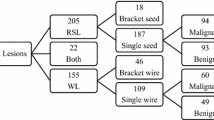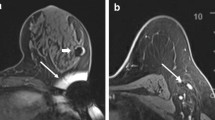Abstract
Background
Nonpalpable breast lesions require precise preoperative localization to facilitate negative margins with breast-conserving therapy. The traditional use of wires has several challenges including patient discomfort, wire migration, and coordination of schedules between radiology and the operating room. Radioactive seed localization overcomes some of these challenges, but radiation safety requirements have limited adoption of this technology. The authors examined their institutional experience with Magseed as an alternative technology for localization and compared outcomes with those of wire and radioactive seed localization.
Methods
An institutional review board (IRB)-approved retrospective study was performed to evaluate patients who underwent excisional biopsy or segmental mastectomy after wire-guided localization (WGL), radioactive seed localization (RSL), or Magseed localization (ML). The clinical and pathologic factors of the three groups were assessed with a negative margin rate as the primary outcome measure.
Results
Of the 1835 patients in the study, 825 underwent WGL, 449 underwent RSL, and 561 underwent ML. For the patients with either multiple lesions or a large lesion that required bracketing, multiple localization devices were placed in 31% of the WGL patients, 28% of the RSL patients, and 23% of the ML patients (p = 0.006). Negative margins were achieved in 91% of the WGL patients, 89% of the RSL patients, and 89% of the ML patients (p = 0.4).
Conclusion
Localization of non-palpable breast lesions using Magseed is a safe and effective alternative to WGL and RSL that overcomes radiation safety limitations and increases radiology and surgery scheduling efficiency.


Similar content being viewed by others
Change history
17 March 2022
A Correction to this paper has been published: https://doi.org/10.1245/s10434-022-11652-8
References
Hall FM, Frank HA. Preoperative localization of nonpalpable breast lesions. AJR Am J Roentgenol. 1979;132:101–5.
Cheang E, Ha R, Thornton CM, Mango VL. Innovations in image-guided preoperative breast lesion localization. Br J Radiol. 2018;91:20170740.
Chan BK, Wiseberg-Firtell JA, Jois RH, Jensen K, Audisio RA. Localization techniques for guided surgical excision of non-palpable breast lesions. Cochrane Database Syst Rev. 2015:CD009206.
Hayes MK. Update on preoperative breast localization. Radiol Clin North Am. 2017;55:591–603.
Jeffries DO, Dossett LA, Jorns JM. Localization for breast surgery: the next generation. Arch Pathol Lab Med. 2017;141:1324–9.
Gray RJ, Salud C, Nguyen K, et al. Randomized prospective evaluation of a novel technique for biopsy or lumpectomy of nonpalpable breast lesions: radioactive seed versus wire localization. Ann Surg Oncol. 2001;8:711–5.
Hughes JH, Mason MC, Gray RJ, et al. A multi-site validation trial of radioactive seed localization as an alternative to wire localization. Breast J. 2008;14:153–7.
Lee MK, Sanaiha Y, Kusske AM, et al. A comparison of two non-radioactive alternatives to wire for the localization of non-palpable breast cancers. Breast Cancer Res Treat. 2020;182:299–303.
Price ER, Khoury AL, Esserman LJ, Joe BN, Alvarado MD. Initial clinical experience with an inducible magnetic seed system for preoperative breast lesion localization. AJR Am J Roentgenol. 2018;210:913–7.
Micha AE, Sinnett V, Downey K, et al. Patient and clinician satisfaction and clinical outcomes of Magseed compared with wire-guided localisation for impalpable breast lesions. Breast Cancer. 2021;28:196–205.
Tayeh S, Gera R, Perry N, Michell M, Malhotra A, Mokbel K. The use of magnetic seeds and radiofrequency identifier tags in breast surgery for non-palpable lesions. Anticancer Res. 2020;40:315–21.
Singh P, Scoggins ME, Sahin AA, et al. Effectiveness and safety of Magseed localization for excision of breast lesions. Ann Surg Open. 2020;1:e008.
Moran MS, Schnitt SJ, Giuliano AE, et al. Society of Surgical Oncology-American Society for Radiation Oncology consensus guideline on margins for breast-conserving surgery with whole-breast irradiation in stages I and II invasive breast cancer. Ann Surg Oncol. 2014;21:704–16.
Zacharioudakis K, Down S, Bholah Z, et al. Is the future magnetic? Magseed localisation for non palpable breast cancer: a multi-centre non-randomised control study. Eur J Surg Oncol. 2019;45:2016–21.
Gera R, Tayeh S, Al-Reefy S, Mokbel K. Evolving role of Magseed in wireless localization of breast lesions: systematic review and pooled analysis of 1559 procedures. Anticancer Res. 2020;40:1809–15.
Somasundaram SK, Potter S, Elgammal S, et al. Impalpable breast lesion localisation, a logistical challenge: results of the UK iBRA-NET national practice questionnaire. Breast Cancer Res Treat. 2021;185:13–20.
Zhang Y, Seely J, Cordeiro E, et al. Radioactive seed localization versus wire-guided localization for nonpalpable breast cancer: a cost and operating room efficiency analysis. Ann Surg Oncol. 2017;24:3567–73.
Kapoor MM, Patel MM, Scoggins ME. The wire and beyond: recent advances in breast imaging preoperative needle localization. Radiographics. 2019;39:1886–906.
Thekkinkattil D, Kaushik M, Hoosein MM, et al. A prospective, single-arm, multicentre clinical evaluation of a new localisation technique using non-radioactive Magseeds for surgery of clinically occult breast lesions. Clin Radiol. 2019;74:974 e977-974 e911.
Acknowledgments
This study was supported by MD Anderson Cancer Center Core Grant P30 CA016672. C. K. Luo is supported by the Cancer Prevention and Research Institute of Texas (CPRIT RP210028).
Disclosure
Kelly K. Hunt, MD, serves on the medical advisory board for Armada Health and receives research funding to her institution from Cairn Surgical, Eli Lilly & Co., and Lumicell. The remaining authors have no conflicts of interest.
Author information
Authors and Affiliations
Corresponding author
Additional information
Publisher's Note
Springer Nature remains neutral with regard to jurisdictional claims in published maps and institutional affiliations.
The original online version of this article was revised: The acknowledgments were corrected.
Rights and permissions
About this article
Cite this article
Liang, D.H., Black, D., Yi, M. et al. Clinical Outcomes Using Magnetic Seeds as a Non-wire, Non-radioactive Alternative for Localization of Non-palpable Breast Lesions. Ann Surg Oncol 29, 3822–3828 (2022). https://doi.org/10.1245/s10434-022-11443-1
Received:
Accepted:
Published:
Issue Date:
DOI: https://doi.org/10.1245/s10434-022-11443-1




